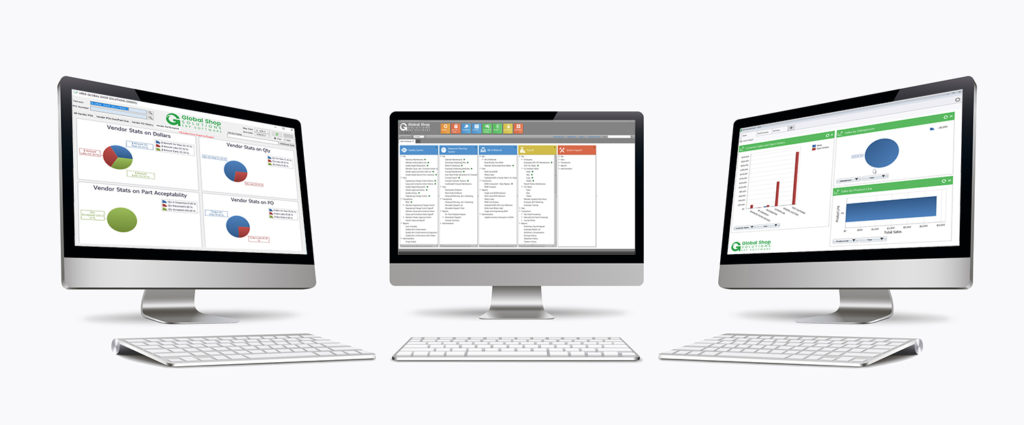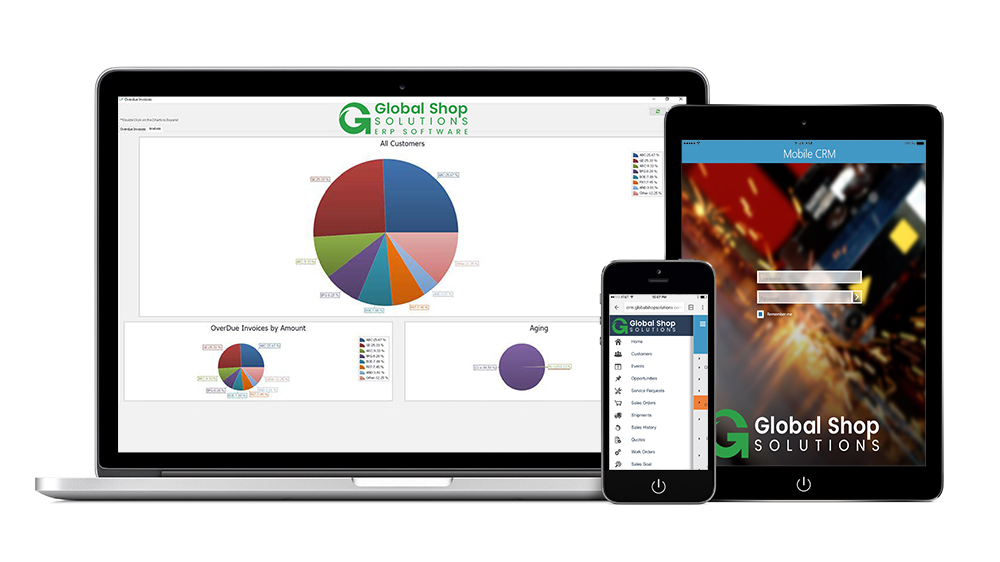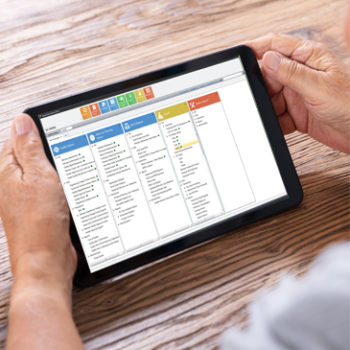Your ERP implementation is an exciting step toward simplified manufacturing. During your ERP implementation at Global Shop Solutions, you will be assisted by your Project Manager, your Operations Consultant, your Financial Consultant, and a full team of implementation experts. Your Project Manager will lead your implementation strategy and assist with milestone tracking, scheduling, and change management. Your Consultants will develop system configurations, conduct system training, and direct you in data migration. They will guide you through any unique or complex configurations and assist with implementing best practices to ensure you and your team get the most out of your Global Shop Solutions implementation.
Based on our years of experience, we have identified six activities that will position your company for a thorough and successful implementation process.
1. Set Clear Goals and Objectives
To ensure a successful implementation, two things must occur at this stage of the process.
1. Identify what your company would like to gain through this implementation. Work collaboratively with your management team and the Implementation Team to create your list of goals and determine the type of implementation that’s right for you: Standard or Fast Track.
2. Communicate those goals, in writing, to your Global Shop Solutions Consultant or Project Manager.
Why is this so important?
Communicating your goals to us in written format will lay the foundation for a swift and successful implementation and will prevent lengthy delays and false starts due to miscommunication and incorrect assumptions.
In order to properly train your people to achieve your desired objectives, our Implementation Team needs to know what you expect from the system and what you aim to accomplish. In addition, having written goals ensures that we both remain in alignment and on track as we move through the implementation process.
When identifying your goals, avoid generic terms such as “simplify the business” or “enhance our competitive position.” Instead, be as specific as possible. For example, do you want to improve on-time deliveries? Reduce waste and rework? Improve machine and labor efficiencies? Simplify the purchasing and inventory management systems?
Global Shop Solutions can help you accomplish all these things and more, but we need to know what specific outcomes you want to achieve so that we can customize your training to your unique circumstances and help you make the right decisions about how to set up the system, format the data, and put the information in the hands of the people who need it to perform their jobs.
2. Understanding the Data Migration Process
The second preparation step involves getting all your business information ready to be transferred into Global Shop Solutions. In technical terms, this is called “migrating” the data.
Data migration is essential for two reasons. One, the information you use to run your business gets transferred into the new system. Two, most people don’t really start understanding Global Shop Solutions software until they use it with their actual data to perform their jobs daily.

In general, the data used to run a business can be broken down into three distinct categories:
- Static data consists of the core business data that doesn’t change every day or with every transaction. Examples of static data include customer database information, customer ship-to ID numbers, vendors, inventory part numbers for raw materials, finished goods, employee information and workcenters for different machinery.
- Transactional data changes on a daily basis. It includes information such as open sales orders, open work orders, all accounting functions, open purchase orders, and inventory count.
- Historical data includes any information that will be used as a historical reference once it is moved over to the new system. For example, information like sales history, work order history, or AP and AR history.
Data migration involves moving all three categories of information from your current system into Global Shop Solutions so that users can quickly and easily find the information they need to perform their jobs. Preparing for the data migration process consists of these basic steps:
- Locate and identify your core data. Many companies keep their data in different locations and formats, such as spreadsheets, computer databases, Word files and even manual documents and ledgers.
- Identify who is responsible for the data. Identify the individual responsible for maintaining each specific area, such as accounting data, customer database, purchasing, parts and inventory and so on.
- Determine how you will clean up the data. Once data gets into a system it tends to stay there, and the last thing you want to do is bring years of outdated historical data that no one will use into the new system. Now is the time to review all your data and decide which information should migrate into the new system and which should get thrown out.
At this point in the process, don’t worry about the actual mechanics of the data migration. Global Shop Solutions offers a number of tools to help you with the conversion process. At the appropriate time, we will discuss data conversion in great detail to ensure that this important step goes as smoothly as possible.
The key is to map out in advance how you will collect your core data and how you will get it from where it is today into the Global Shop Solutions system.
3. Familiarize Yourself With the Software
One of the biggest mistakes companies make when implementing enterprise-wide software is waiting until the last minute to start learning it. Now is the time to dive in and start learning about the different screens, fields and terminology in Global Shop Solutions software. Familiarizing yourself with the system can be accomplished in several ways.
- Go to the Help menu. One good way to start learning the system is to browse the Help menus. Simply download the information about a particular topic, print it out, and use the hard copy to guide you through the process.
- Go online. Global Shop Solutions’ web-based training classes offer a great way to learn the basics of the system as well as specifics about various areas within the system.
- Go exploring. Perhaps the best way to start getting a feel for Global Shop Solutions is to just go in and play with it. Global Shop Solutions software comes loaded with real data and a “play” company. This allows you to go into the system, perform some basic functions (such as entering a part number or customer information) and start getting used to moving around within the system without impacting any of your own data.
4. Define Roles and Responsibilities
Hopefully, your company assembled a cross-functional ERP implementation team either prior to or during the process of purchasing Global Shop Solutions software. If so, this team should now direct its attention to this important step. If not, now is the time to bring together the appropriate people to spearhead the implementation process. For more information on how to put together an effective implementation team, please see our blog “Building an ERP Taskforce.”
Once your team is in place, the next step involves assigning specific roles and responsibilities for the implementation process. For example, who will be the primary interface between the Global Shop Solutions Project Manager and your company? Who will assume responsibility for overseeing the data migration process? Who will decide when training will occur and who should attend? Who will have administrative responsibility for the system? Who will be the final arbiter in regards to the system when problems or conflicts arise? These decisions should be made well in advance of your Go Live date.

Defining roles will allow the correct people to see the right data in your ERP system.
It is essential that everyone in your company know who is responsible for each area of your ERP software. So once you define roles, make sure you communicate them throughout your company.
5. Begin Training
Training is an essential part of the implementation process. To help you learn the new system, Global Shop Solutions offers different types of training; here are just a few options for you to choose from:
- ERP Boot Camp provides an overview of the Global Shop Solutions system while walking you through everything from quoting new orders to collecting the cash after a job has been delivered. We strongly recommend that your project manager and/or Implementation Team attend this critical training.
- Virtual training consists of classes where customers can log on to a secure website and participate in a web-based classroom environment that covers topics such as accounts payable and receivable, data conversion, customer relationship management, graphical scheduling, purchasing, shop tracking and much more. In addition, Global Shop Solutions also offers one-on-one training, where one trainer and one customer go through a tutorial on a specific topic using a secure web interface.
- Learning Management System (LMS) provides you the opportunity to understand what you own, learn new skills, refresh existing skills, and test and certify yourself at your own speed since all the training is online and self-service. Administrators can assign courses, track progress, and reward employees that do well.
- FastTRAIN is a subscription-based, online video platform loaded with pre-recorded videos led by experts showing you different parts of the system.
- Friday Features is a weekly webinar occurring Fridays each Spring and Fall that shows you items core in the system as well as newly-launched products.
The long-term results you achieve from Global Shop Solutions will depend to a large extent on ensuring that your people receive sufficient training on the software. As a rule of thumb, you can never start training too early and
you can never have too much.
6. Management Support
Even when you do a thorough job of preparing, there is still one major obstacle that will derail any implementation effort – a lack of management support.
Implementing Global Shop Solutions software represents a huge change for your company, and it needs to be managed and supported accordingly. When converting to the Global Shop Solutions system, your company will undergo a significant change in the way it conducts business. People will resist this change because it represents the unknown. Some will start out with good intentions but gradually slip back into the old way of doing things. Others will resist from day one. If management wavers and allows people to avoid using the system, it will slow down the implementation process and delay the return on investment your company is looking for.
What can management do to keep the momentum going?
- Demonstrate your commitment. Demonstrate, through your words and your actions, that management is 100% committed to the new system. The best way to do that is to learn the system and begin using it as soon as possible. Lead by example.
- Create a vision of the future. To help people overcome their anxieties and fear of change, paint a picture for employees of how their jobs will be easier and more efficient with the new system. Explain how a leaner, more competitive company enhances job security and increases opportunity for advancement within the company.
- Get employee buy-in. In order to fully utilize Global Shop Solutions, employees must feel like they “own” the system. The best way to generate a sense of ownership is to give people plenty of training on the software with the actual data they use to perform their jobs.
- Hold people accountable. Insist that people learn and use the new system. Provide rewards for those that do and consequences for those that don’t.
- Communicate on a regular basis. Ongoing communication from the top is essential with any major change initiative. Clearly communicate goals, objectives, deadlines and anything else about the implementation process that affects employees.
- Celebrate the wins. As the implementation process unfolds and people begin to embrace the new system, update employees on any and all progress toward your goals. Publicly recognize the “early adopters” and those who lead the way in using the system. Celebrate the achievement of milestones and interim objectives, constantly keeping people focused on the big picture of a leaner, more efficient company once the new system is up and running.
Finally, stick to your implementation plan as much as possible. Obviously, no plan — no matter how well written — unfolds without some bumps. However, we strongly recommend following the steps in your plan from start to finish, even if the timeline gets a bit off track. When minor obstacles occur, stick to the components of the plan as much as possible, but be prepared to adjust the timeline to accommodate circumstances that may arise.
This is an exciting time for you and your company. You are about to embark on a journey that will enable your company to cut costs, increase operating efficiencies and improve on-time deliveries while dramatically strengthening your ability to compete within your industry. As you and your company set off on this journey, rest assured that we are with you every step of the way. Our immediate objective is to deliver a successful implementation so that you can simplify your business and take it to the next level. Our long- term goal is to have you and/or the management team look back in six months to a year and say, “Implementing Global Shop was the best decision we ever made for this company!”


 USA
USA
 United States
United States Indonesia
Indonesia Mexico
Mexico Australia
Australia United Kingdom
United Kingdom New Zealand
New Zealand Singapore
Singapore